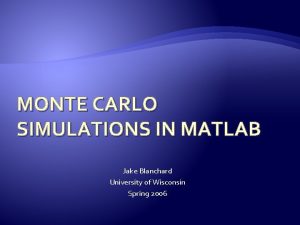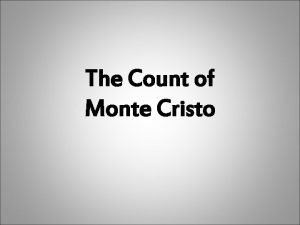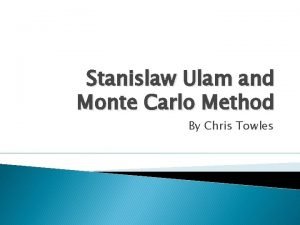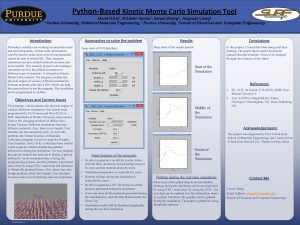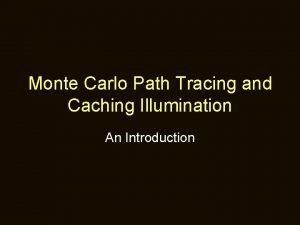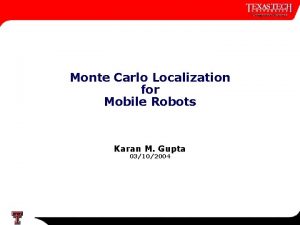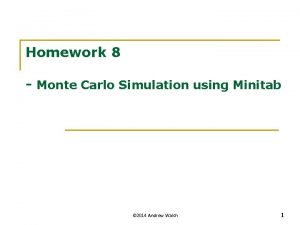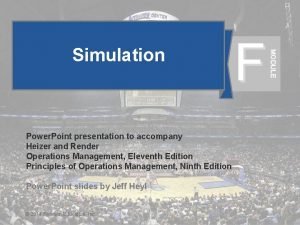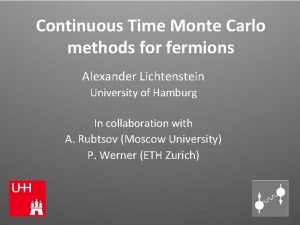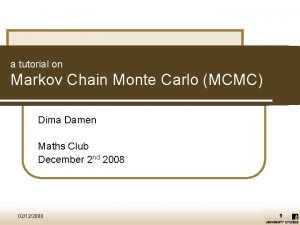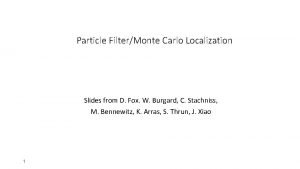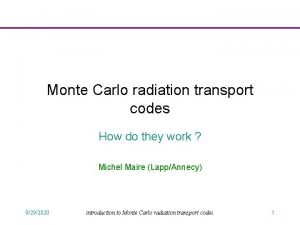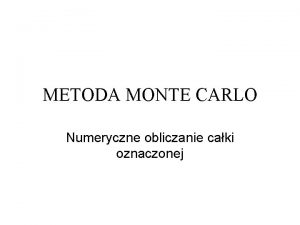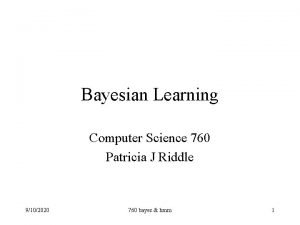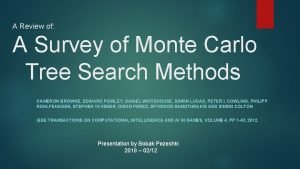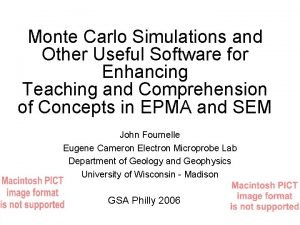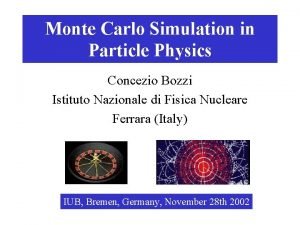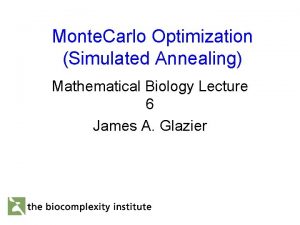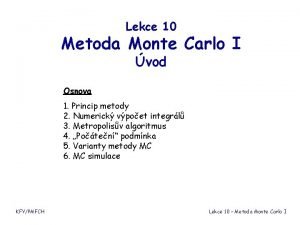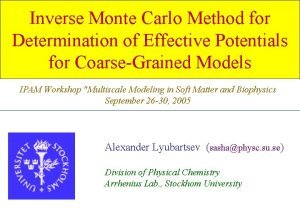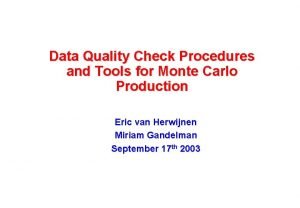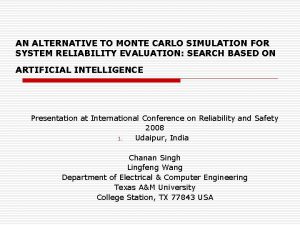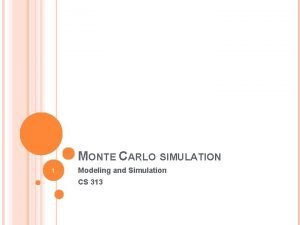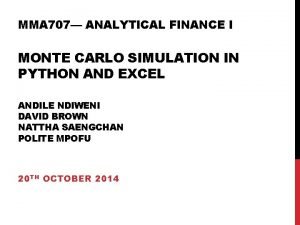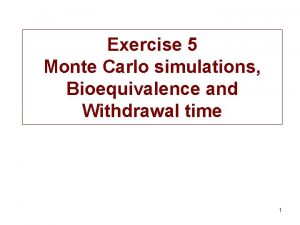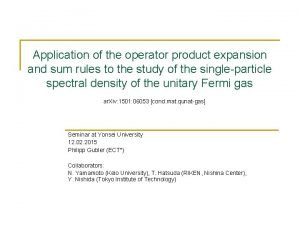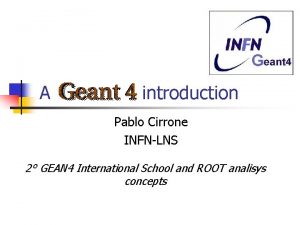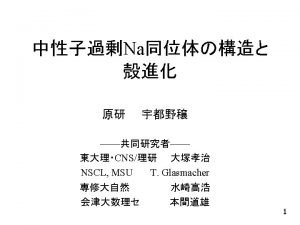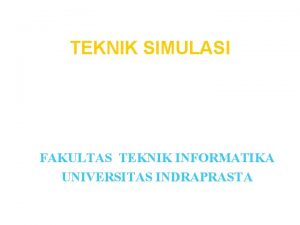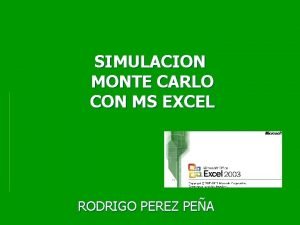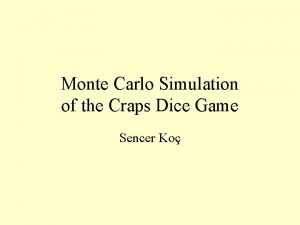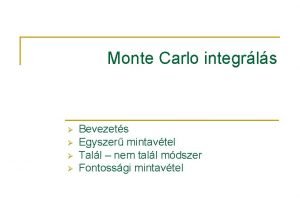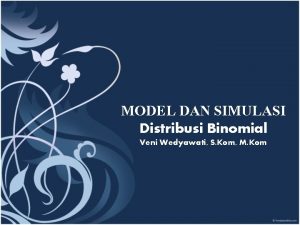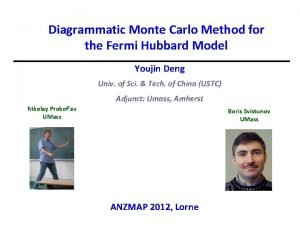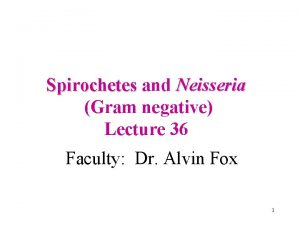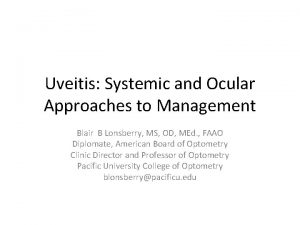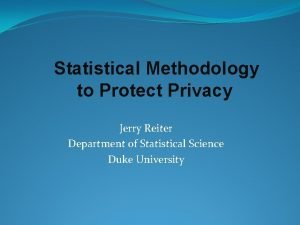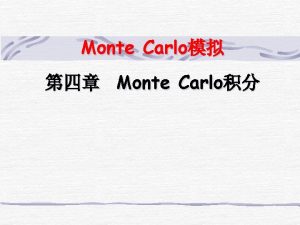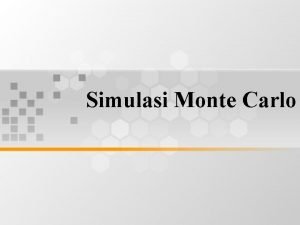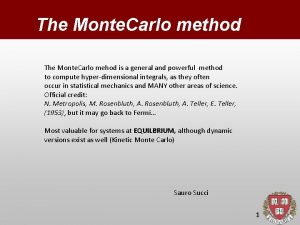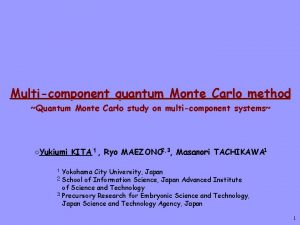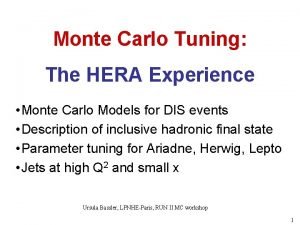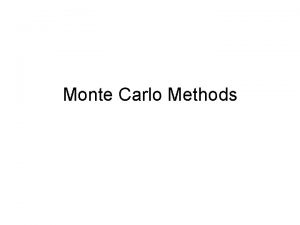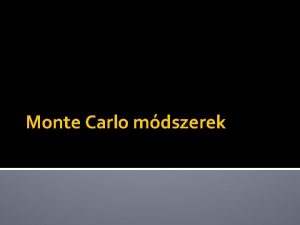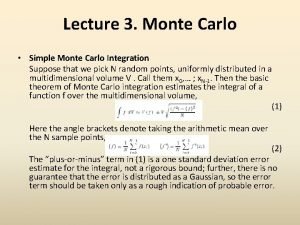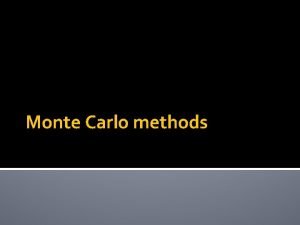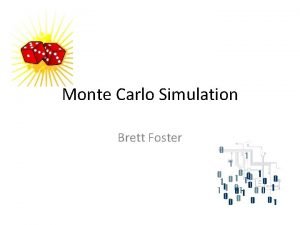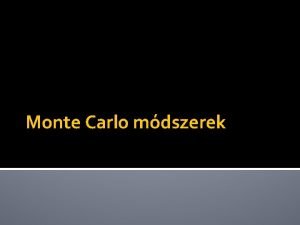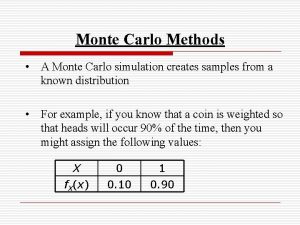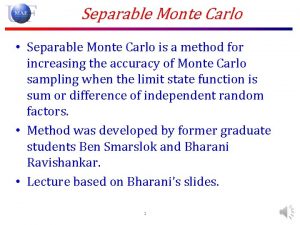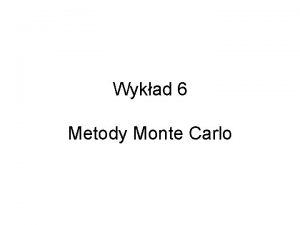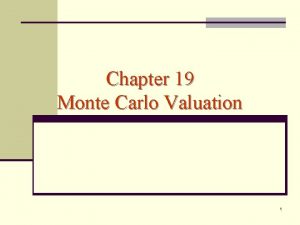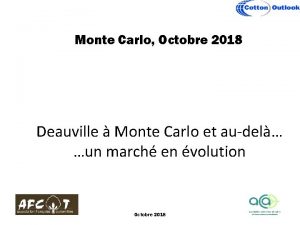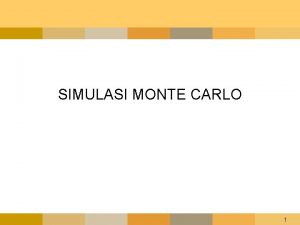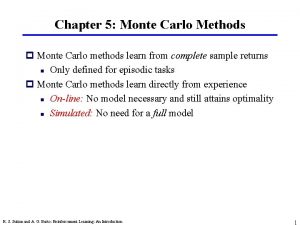The Monte Carlo Method an Introduction Detlev Reiter




















































- Slides: 52

The Monte Carlo Method: an Introduction Detlev Reiter Research Centre Jülich (FZJ) D -52425 Jülich http: //www. fz-juelich. de e-mail: d. reiter@fz-juelich. de Tel. : 02461 / 61 -5841 Vorlesung HHU Düsseldorf, WS 07/08 March 2008

There are two dominant methods of simulation for complex many particle systems 1) Molecular Dynamics • • Solve the classical equations of motion from mechanics. Particles interact via a given interaction potential. Deterministic behaviour (within numerical precision). Find temporal evolution. 2) Monte Carlo Simulation • • Find mean values (expectation values) of some system components. Random behaviour from given probability distribution laws. The Monte Carlo technique is a very far spread technique, because it is not limited to systems of particles.

This lecture • Brief introduction: simulation • What is the Monte Carlo Method • Random number generation • Integration by Monte Carlo Tomorrow: one (of many) particular application: • particle transport by Monte Carlo

ASDEX-UPDRADE (IPP Garching) 4

Monte Carlo particle trajectories, ions and neutral particles






First application of Monte Carlo Method The needle experiment of Compte de Buffon, 1733 (french biologist, 1707 -1788 What is the probability p, that a needle (length L), which randomly falls on a sheet, crosses one of the lines (distance D)? (N trials, n „hits“)

Yt =1, if crossing, Yt=0 else, then

Today: Using a computer to generate random events: We need to be able to generate random numbers X with any given probability function f(x), or a given cumulative distribution F(x). 1) Uniformly distributed random numbers 2) General random numbers: can be obtained from a sequence of independent uniform random numbers

Random number generation f(x) 1/(b-a) a b



We will see next: Any continuous distribution can be generated from uniform random numbers on [0, 1] Any discrete distribution can be generated from uniform random numbers on [0, 1] Hence: Any given distribution can be generated from uniform random numbers on [0, 1]


Strategy: try to transform F to another distribution, such that inverse of new F is explicitly known.

Example: Normal (Gaussian) distribution Cumulative distr. function Inverse cumul. distr. fct. best format of storing distributions for Monte Carlo applications: „Inverse cumulative distribution function F-1(x)“, x uniform [0, 1]

Exercise (and most important example: ) Generate random numbers from a Gaussian. Let X, Y two independent Gaussian random numbers. Transform to polar coordiantes (Jacobian!) R, Φ Sample Φ (trivial, it is uniform on 2π) Apply inversion method for R Transform sampled Φ, R back to X, Y. This is a pair of Gaussians. (Box-Muller Method)

Exponential distribution by „inversion“ Note: Z and 1 -Z have same distrib. (see tomorrow)


Cauchy: e. g. : natural Line broadening

(stepwise constant, with steps at points T)



Rejection y=f(x): distribution density enclosing rectangle Reject z Accept z, take x=z y uniform sample x from f(x) X z, uniform

NEXT: Any Monte Carlo estimate can be regarded as a mean value, i. e. an integral (or sum) over a given probability distribution, ususally in a high dimensional space (e. g. of random walks…. ) Generic Monte Carlo: Integration Hence: How does Monte Carlo integration work?


Hit or Miss f(x) x 2 uniform I: unknown area miss hit I = ∫ f(x) dx X x 1, uniform







Suggestion: try again with previous example from dull and crude Monte Carlo









Outlook: next lecture (tomorrow)


END



 Monte carlo integration matlab
Monte carlo integration matlab Count of monte carlo
Count of monte carlo Stanislaw ulam monte carlo
Stanislaw ulam monte carlo Contoh kasus simulasi monte carlo
Contoh kasus simulasi monte carlo Mnemstudio
Mnemstudio Kinetic monte carlo python
Kinetic monte carlo python Connect 4 monte carlo tree search
Connect 4 monte carlo tree search Eric veach thesis
Eric veach thesis Monte carlo localization for mobile robots
Monte carlo localization for mobile robots Monte carlo in minitab
Monte carlo in minitab Monte carlo simulation advantages and disadvantages ppt
Monte carlo simulation advantages and disadvantages ppt Continuous time monte carlo
Continuous time monte carlo Markov chain monte carlo tutorial
Markov chain monte carlo tutorial Monte carlo localization python
Monte carlo localization python Monte carlo radiation transport
Monte carlo radiation transport Metoda monte carlo algorytm
Metoda monte carlo algorytm Monte carlo search tree
Monte carlo search tree Monte carlo search tree
Monte carlo search tree Monte carlo simulation freeware
Monte carlo simulation freeware Concezio bozzi
Concezio bozzi Monte carlo optimization
Monte carlo optimization Metoda monte carlo
Metoda monte carlo Inverse monte carlo
Inverse monte carlo Villa monte carlo
Villa monte carlo Monte carlo data quality
Monte carlo data quality Monte carlo simulation alternatives
Monte carlo simulation alternatives Rembrandt self protrait
Rembrandt self protrait Monte carlo truth
Monte carlo truth Equilikely
Equilikely Monte carlo simulation
Monte carlo simulation Monte carlo exercise
Monte carlo exercise Monte carlo exercise
Monte carlo exercise Quantum monte carlo
Quantum monte carlo The monte carlo
The monte carlo Monte carlo sd
Monte carlo sd Contoh soal simulasi monte carlo
Contoh soal simulasi monte carlo Distribucion poisson excel
Distribucion poisson excel Monte carlo simulation dice roll matlab
Monte carlo simulation dice roll matlab Monte carlo szimuláció példa
Monte carlo szimuláció példa Contoh soal distribusi binomial
Contoh soal distribusi binomial Contoh simulasi monte carlo
Contoh simulasi monte carlo Minitab headquarters
Minitab headquarters Diagrammatic monte carlo
Diagrammatic monte carlo Detlev nitsche
Detlev nitsche Detlev jöcker du bist immer da
Detlev jöcker du bist immer da Reiter’s syndrome
Reiter’s syndrome Lifecell myco +
Lifecell myco + Dr pugliese allergist
Dr pugliese allergist Psödogut
Psödogut Reiter’s syndrome
Reiter’s syndrome Reactive arthritis
Reactive arthritis Jerry reiter duke
Jerry reiter duke Lou reiter
Lou reiter
